| |
In the following
article I will relate history that should prove enlightening, as some 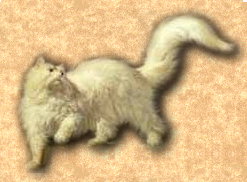 breeder's
view of such history of the Turkish Angora is somewhat more exact than others.
Already in the sixteenth century, medium-haired cats were brought as gifts for
the European aristocracy by trading vessels from the Orient to Europe. Here in
Europe the medium-haired breed was highly esteemed, in contrast to the native
short-haired cats. In noblemen's houses they were spoiled and were not sold for
an insignificant price. breeder's
view of such history of the Turkish Angora is somewhat more exact than others.
Already in the sixteenth century, medium-haired cats were brought as gifts for
the European aristocracy by trading vessels from the Orient to Europe. Here in
Europe the medium-haired breed was highly esteemed, in contrast to the native
short-haired cats. In noblemen's houses they were spoiled and were not sold for
an insignificant price. So much for
prehistory.
By the end of the nineteenth century, the beautiful medium-haired cats were to be found much more frequently in middle-class
homes. Other medium
longhair cats came from the Mediterranian and Russian and areas and were
inter-bred. From this mix, the Persian was created, which at this time naturally appeared quite different than today's Persian
breed. At the same
time, the Angora still
With the rising popularity of the Persian, the Turkish Angora lagged further and further
behind. Bloodlines with Angora Persian mixtures were favored at
this time. The Angora was used in the Persian breeding program until the Persian type
dominated. In 1899, pure Turkish Angoras were registered for
the last time, and afterwards the Turkish Angora seemed to be extinct and was no longer available in Europe and the USA. 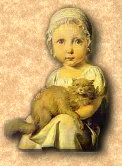 In the 60's the purity of Turkish Angoras still living in their homeland of
Turkey, was In the 60's the purity of Turkish Angoras still living in their homeland of
Turkey, was threatened. To ensure survival of the breed, the zoos of Ankara
and Istanbul collected and bred the best existing examples of the breed. This was all the more important to some of those involved because a local
religious legend related that the death of Kemal Ataturk in 1938 would someday result in his reincarnation as a white cat with odd
eyes.
threatened. To ensure survival of the breed, the zoos of Ankara
and Istanbul collected and bred the best existing examples of the breed. This was all the more important to some of those involved because a local
religious legend related that the death of Kemal Ataturk in 1938 would someday result in his reincarnation as a white cat with odd
eyes.
It was very difficult to obtain a cat from the zoos at this point in time because it was feared that the above mentioned Turkish gentleman might find
his rebirth taking place overseas, with no possibility to come back to his
own country.
Nevertheless, in 1954 the American, Lyn Pierce (Kenlyn Cattery), succeeded
to import a Turkish Angora cat with the name Pucette Michelle (odd eyed white) from the
Istanbul zoo to America. This cat was not bred, since another cat of that breed was not
available, being only found in the area of Ankara. However,
in the 60's, the first Turkish Angoras came to the USA and Canada as imports.
Later, many zoo cats from
the Istanbul zoo were accepted, since this zoo's cats likewise originated from Ankara zoo
cats.
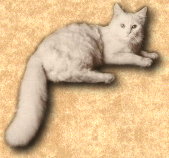 In 1962 Mr. H. Kenan Taspinar (Taspinar Cattery) imported a white odd-eyed female from
a private Turkish Angora breeder from Ankara. These Turkish breeders' cats were also merged into the Ankara zoo
program, so that these animals became
related to one another again. In 1968 Mr. Taspinar also imported five Turkish Angora
cats, including a silver tabby Turkish Angora. In 1970, Mr.
Taspinar left his entire cattery to Mrs. Gisela Stoschek (Tai Phoon Cattery).
In 1962 Mr. H. Kenan Taspinar (Taspinar Cattery) imported a white odd-eyed female from
a private Turkish Angora breeder from Ankara. These Turkish breeders' cats were also merged into the Ankara zoo
program, so that these animals became
related to one another again. In 1968 Mr. Taspinar also imported five Turkish Angora
cats, including a silver tabby Turkish Angora. In 1970, Mr.
Taspinar left his entire cattery to Mrs. Gisela Stoschek (Tai Phoon Cattery).
Mrs. Stoschek bred some these animals with other breeds, such as the Siamese and the
Persian. Fortunately, the registration of these hybrid descendants
were refused by CFA and were removed entirely from the breed's gene pool.
In 1963 Colonel and Mrs. Walter Grant imported a pair of white Turkish Angoras. These two are famous in the history of the Turkish
Angora. Their
names were Yildiz and Yildizcek, having been born in the Ankara zoo one year before their
importation. The first descendants of these two cats, the
Grants sold exclusively kastriert, because they wanted to guarantee that their cats were bred only with Ankara zoo
cats, or whose pure descent was proven. To begin the breed with a good gene pool
base, the Grants imported a further pair cats from the Ankara zoo in 1966. Years
later, many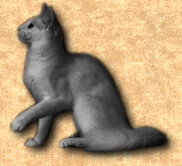 catteries trace their descendants back to these cats.
catteries trace their descendants back to these cats.
Almost at the same time, i.e. in the year 1964, Sgt. and Mrs. Brook imported a pair of white Angoras from the Ankara
zoo. Their names were Sam Olgum and
Aliya's Snowball. Mrs. Brook co-operated closely with Mrs. Lee Thornton (Thornton cattery was registered with CFA, Thornton's Desert Cattery in the
other cat associations) who helped the Brooks to register these animals. In 1965 Mrs. Thornton obrained yet another white odd-eyed Turkish Angora female
with the name Belkzar, who was bred later with a male named Sam Of Mountain Home
(owner Mrs. Brown). The descendants of this mating became a branch of
Turkish Angoras in which Grant and Brooks' lines formed the basic stock of Thornton
Cattery.
In the early 70's, cats were imported from the zoos to Germany and the
Netherlands. A significant role was played by the zoologist Dr. Reimann (Tha
Makhuas Cattery) and Mrs. Nadja Mardak (Cattery Ueskuedarsaray) in Germany.
A further well-known name in this connection are Thomas and Virginia Torio (Torio
Cattery), who imported their first Turkish Angora at 6 weeks of age
from the Ankara zoo. This cat was a sweet white female with the name "Gelin
Of Torio."
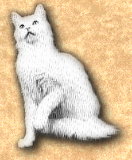 In 1973 CFA accepted the Turkish Angora for showing for the first time. However, CFA only accepted the white
cats. This raised new problems in the
Turkish Angora breed. On the one hand it was known that constant breeding of whites to whites increased a certain potential for
deafness, on the other
hand, one could not register the colored offspring from these breedings, except as unregistered
cats. However, the worst effect of the acceptance of
whites only was the substantial cut in the gene pool available for breeding. There were very few Turkish
Angoras, and most were from
the Ankrara zoo, whose gene pool with at that time consisted of 30 animals, and so was very
limited. Because the colored animals could not be
registered and used for breeding, the gene pool became smaller still. Pedigrees with 4-6 factor in-breeding were not rare. In 1973, the breeders
Aletha Hendrickson (Kukkula Acres Cattery) with exactly this reason in mind, asked for registration status of the colored Turkish
Angoras. In 1978, CFA finally accepted the colors.
In 1973 CFA accepted the Turkish Angora for showing for the first time. However, CFA only accepted the white
cats. This raised new problems in the
Turkish Angora breed. On the one hand it was known that constant breeding of whites to whites increased a certain potential for
deafness, on the other
hand, one could not register the colored offspring from these breedings, except as unregistered
cats. However, the worst effect of the acceptance of
whites only was the substantial cut in the gene pool available for breeding. There were very few Turkish
Angoras, and most were from
the Ankrara zoo, whose gene pool with at that time consisted of 30 animals, and so was very
limited. Because the colored animals could not be
registered and used for breeding, the gene pool became smaller still. Pedigrees with 4-6 factor in-breeding were not rare. In 1973, the breeders
Aletha Hendrickson (Kukkula Acres Cattery) with exactly this reason in mind, asked for registration status of the colored Turkish
Angoras. In 1978, CFA finally accepted the colors.
In Germany, breeders worked for acceptance of the breed. Attempts to obtain acceptance failed in the 80's, because of agressiveness the cats exhibited
when they were taken to shows. Perhaps this was fortunate for the Turkish Angora, because this caused breeders to pay special attention to
strengthening the sweet temperament of the Turkish Angora. In 1988, German breeders finally succeeded in obtaining acceptance of the white Turkish
Angora, followed by acceptance of colors in 1994.
Meanwhile more than 20 years of virtually closed breeding took place in the USA, just as closed breeding also took place in the zoos of Ankara and
Instanbul. In the USA, the cats were bred to conform to one standard, while in the
zoos, another standard was used.
Due to the different criteria for selection of breeding stock, the descendants of the Turkish Angoras began to diverge in their appearance and
qualities. The descendants of the original animals in the USA became more graceful and elegant over the decades with pronounced ear
size. Meanwhile,
the descendants of the original cats which still resided in the zoos of Turkey, became heavier and rougher in type with very moderate ear
size.
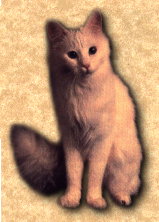 This divergence is still seen
today. The variation in the appearance of the
Turkish Angoras which are being bred today differs more and more. It would
be wonderful, if breeders and judges could even agree on a "middle
course." In my opinion, the harmony of the whole animal, which is radiated by a
Turkish Angora, is extremely important. Elegance and beauty must not be lost under any
circumstances. Neither resemblance to an Oriental nor to a
Maine Coon are appropriate. One example of a wonderfully harmonious Turkish
Angora is No Ruz Kristal Of Azima, a sweet Turkish Angora female born in the
USA in 1975, the second generation from Turkish imports. Honestly, should This divergence is still seen
today. The variation in the appearance of the
Turkish Angoras which are being bred today differs more and more. It would
be wonderful, if breeders and judges could even agree on a "middle
course." In my opinion, the harmony of the whole animal, which is radiated by a
Turkish Angora, is extremely important. Elegance and beauty must not be lost under any
circumstances. Neither resemblance to an Oriental nor to a
Maine Coon are appropriate. One example of a wonderfully harmonious Turkish
Angora is No Ruz Kristal Of Azima, a sweet Turkish Angora female born in the
USA in 1975, the second generation from Turkish imports. Honestly, should
we not make such cats the model for our cats today?
|
|